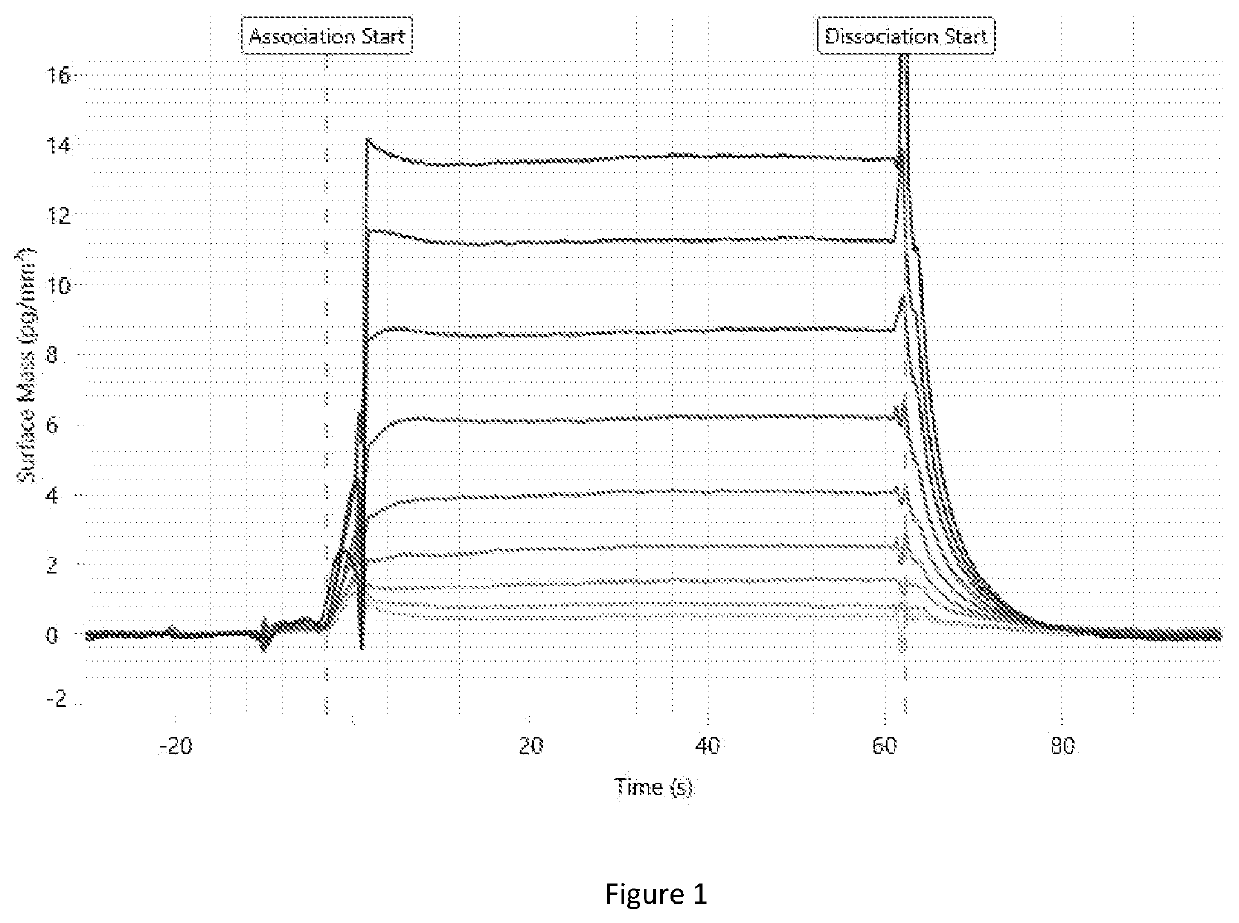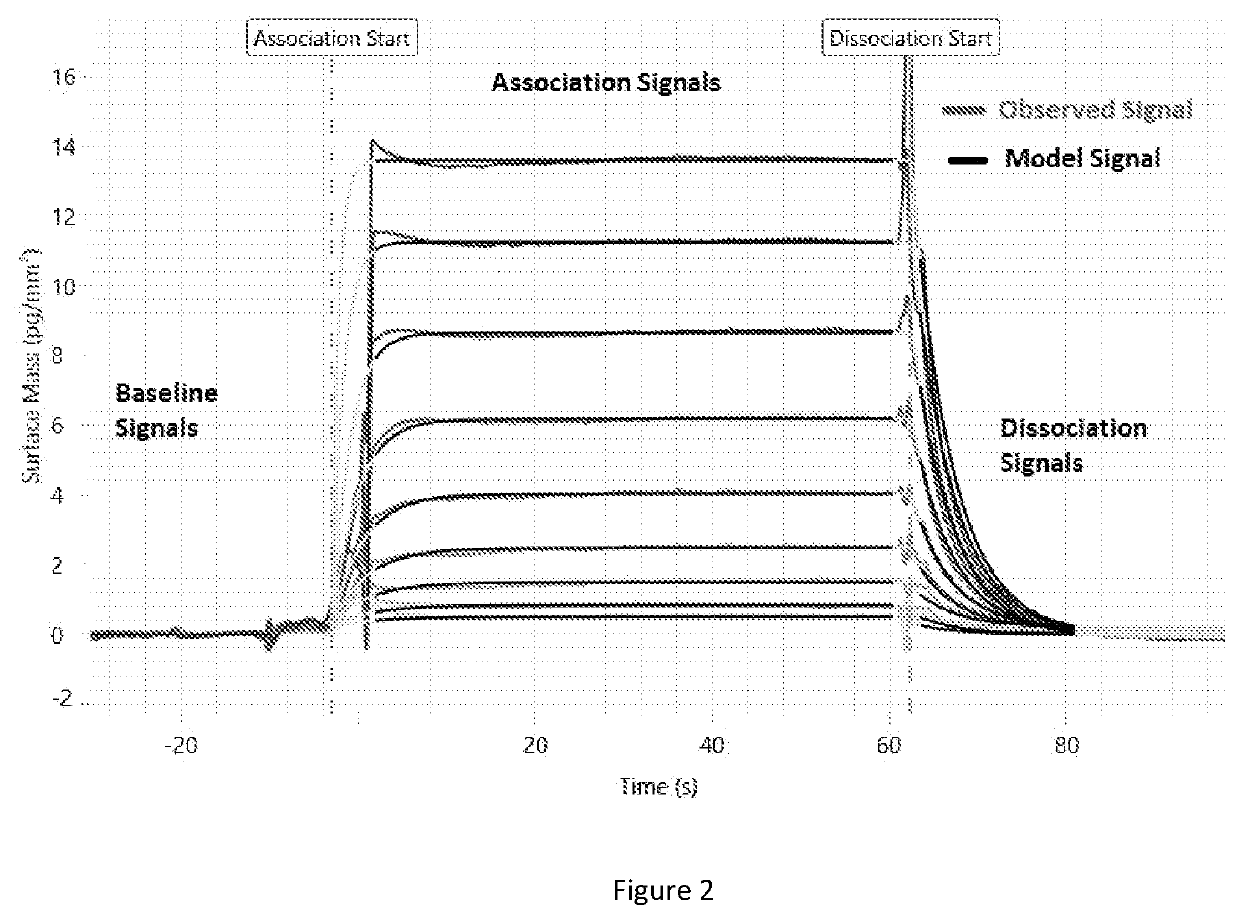Method for calculating kinetic parameters of a reaction network
a reaction network and kinetic parameter technology, applied in the field of methods for calculating kinetic parameters of a reaction network, can solve the problems of affecting the workflow of evaluating an observed signal, affecting the accuracy of the observed signal,
- Summary
- Abstract
- Description
- Claims
- Application Information
AI Technical Summary
Benefits of technology
Problems solved by technology
Method used
Image
Examples
example 1
Reaction Network
[0126]Assume a reversible reaction between an analyte A and a surface-bound (immobilized) capturing molecule, or ligand, B which is not diffusion or mass transfer limited and obeys pseudo first order kinetics:
A+BAB. (36.)
[0127]The state of this reaction network is given by
{xo(t),xh(t)}=([A],[AB])@([B]), (37.)
where the concentrations of the analyte A and the product AB are the observed state, and the concentration of the ligand B is the hidden state.
[0128]The differential equations determining the reaction network state over time are
[{dot over (A)}]=0, (a)
[{dot over (B)}]=−ka[A][B]+kd[AB], (b)
[]=ka[A][B]−kd[AB], (c) (38.)
where the analyte concentration [A] is a known constant.
[0129]Then the integrated form of Equation (38.b) and Equation (38.c) are used to eliminate the ligand concentration as
[{dot over (B)}]=−[]⇒→[B]=R−[AB], (39.)
where R is an ‘integration constant’, namely the initial ligand concentration.
[0130]The elimination steps yield the intermediate diff...
example 2
Reaction Network with an Observed Signal Offset
[0146]An observed signal can contain an observed signal offset, which is an offset constant in time by which the observed signal differs from the model signal. Observed signal offsets are particular common in observed signals which have been obtained by performing an acquisition method using a label-free sensor. In this case, to reliably estimate the kinetic parameters of the reaction network, the observed signal offset needs to be jointly determined with the kinetic parameters. The following embodiment uses a direct estimation method that determines jointly the kinetic parameters and the observed signal offset.
[0147]In such an embodiment the discrepancy function is
[]−ka[A](R−e−[AB])+kd[AB]+kd·e=0, (53.)
wherein e is an observed signal offset to the observed signal as [AB]→[AB]+e in Equation (40.), and which is overparametrized by R and e that are exchangeable degrees of freedom.
[0148]The estimation of the parameters ka, kd, R and e is ...
example 3
ady State Mass Transport Reaction Network
[0166]Common observed signals a represented by reaction networks involving an analyte diffusing to a surface and then reacting with a ligand immobilized at the surface, reaction which is described by the reaction network
AAs+BAsB. (64.)
Hereafter, [As] is the surface analyte concentration, the concentration of the analyte at the surface where the ligand is immobilized. When the diffusion of the analyte to the surface is slow, the surface analyte concentration becomes time dependent and differs from the fixed analyte concentration [A], reason the surface analyte concentration needs to be modelled.
[0167]The state of this reaction network is described by
{xo(t),xh(t)}([A],[AsB])@([As],[B]), (65.)
where the concentrations of the analyte and the complex are observed states, and the concentrations of the surface analyte and ligand are hidden states.
[0168]The differential equations determining the time evolution of the reaction network state over time...
PUM
 Login to View More
Login to View More Abstract
Description
Claims
Application Information
 Login to View More
Login to View More - R&D
- Intellectual Property
- Life Sciences
- Materials
- Tech Scout
- Unparalleled Data Quality
- Higher Quality Content
- 60% Fewer Hallucinations
Browse by: Latest US Patents, China's latest patents, Technical Efficacy Thesaurus, Application Domain, Technology Topic, Popular Technical Reports.
© 2025 PatSnap. All rights reserved.Legal|Privacy policy|Modern Slavery Act Transparency Statement|Sitemap|About US| Contact US: help@patsnap.com


